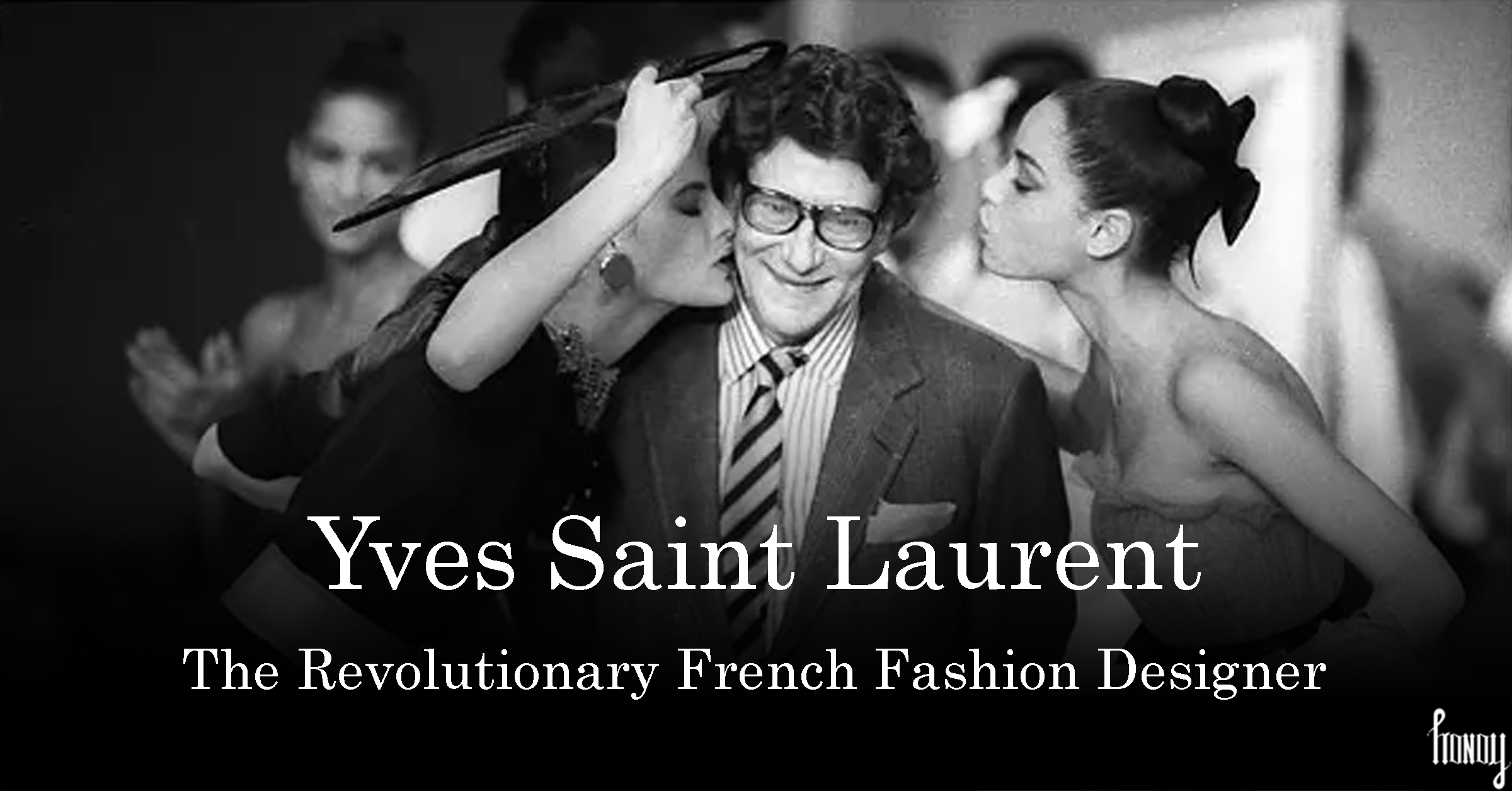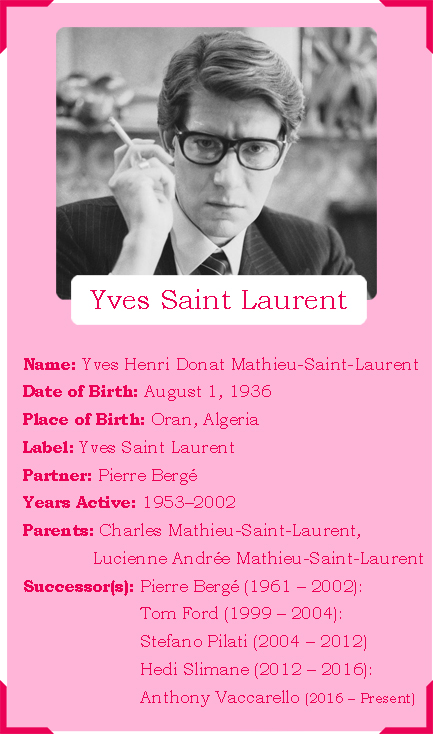Yves Saint Laurent: The Revolutionary French Fashion Designer

Introduction to Yves Saint Laurent

Yves Saint Laurent, often referred to as YSL, is a name synonymous with revolutionary elegance and innovation in the world of fashion. Known for modernizing women’s wear and creating bold, boundary-breaking designs, Saint Laurent’s impact on the fashion industry remains unparalleled. His creativity brought the tuxedo suit for women, “Le Smoking,” into mainstream fashion—a garment that challenged conventional gender norms and redefined femininity in the late 20th century. As Saint Laurent once said, “Fashions fade, style is eternal,” a quote that encapsulates his philosophy and influence, which continues to shape the fashion landscape even today. This blog will dive deep into life, work and fashion philosophies of this legendary Parisian designer and will inspect hi creations, contributions and legacy to the fashion world.
Early Life and Background
Yves Saint Laurent was born in the French colony of Oran, Algeria, into a bourgeois family. His early exposure to fashion came through his mother, Lucienne Andrée Mathieu-Saint-Laurent, who nurtured his creative talents. Even as a child, Yves displayed an affinity for design and frequently created intricate paper dolls, showing his innate understanding of fashion. His first steps into the fashion world were guided by his interest in French couture, particularly the works of Christian Dior. This passion led him to move to Paris at the age of 17 to pursue a formal education in fashion design at the Chambre Syndicale de la Couture Parisienne.
Career Beginnings
Saint Laurent’s entry into the fashion industry began with a bang. At just 18 years old, he caught the attention of Michel de Brunhoff, the editor-in-chief of Vogue Paris, who introduced him to Christian Dior. Impressed by his sketches, Dior hired him as an assistant. The mentorship with Dior was pivotal; when Dior unexpectedly passed away in 1957, the 21-year-old Saint Laurent was appointed the head designer of the House of Dior. His first collection, the Trapèze line, was a resounding success and cemented his position as a leading figure in fashion. However, his tenure at Dior came to an abrupt end in 1960 when he was conscripted into the French army during the Algerian War.
Rise to Fame

Upon his return from military service in 1962, Saint Laurent established his own label, Yves Saint Laurent (YSL), with his partner Pierre Bergé. His debut collection introduced the world to his daring and innovative approach. During the 1960s and 1970s, YSL became renowned for transforming women’s fashion by introducing designs such as the Mondrian dresses, the safari jacket, and the see-through blouse. His 1966 collection featured Le Smoking, a tuxedo suit for women that challenged traditional notions of menswear and empowered women with a newfound sartorial confidence.
Saint Laurent’s popularity soared, and he became known for creating collections that combined haute couture with ready-to-wear. This democratization of fashion was revolutionary and allowed a broader audience to access luxury fashion.
Signature Style and Innovations
Yves Saint Laurent’s style is characterized by its boldness and versatility. He redefined modern fashion by incorporating elements of art, culture, and androgyny into his designs. His love for contemporary art led to the creation of the Mondrian dress in 1965, inspired by Dutch painter Piet Mondrian’s abstract geometric works. Similarly, his African-inspired collection featured bold prints and exotic themes that introduced a new visual language to Western fashion.
Saint Laurent’s contributions also include the introduction of the “safari look” and the first tuxedo jacket for women. These designs were radical departures from the conventional silhouettes of the time and have since become iconic pieces in fashion history. Saint Laurent was also known for pioneering the prêt-à-porter (ready-to-wear) line, bridging the gap between couture and everyday wear.
Mondrian Dress and Pop Art Influence (1965)
One of Yves Saint Laurent’s revolutionary contributions to fashion came in 1965 with the creation of the Mondrian dress. Inspired by the works of Dutch artist Piet Mondrian, Saint Laurent translated the geometric patterns of Mondrian’s paintings into a groundbreaking dress that seamlessly blended art and fashion. This bold move not only demonstrated Saint Laurent’s avant-garde approach but also marked the intersection of high fashion and pop art.
The Mondrian dress became an instant sensation, symbolizing a shift in the fashion landscape. Its impact is still felt today, and the dress itself is housed in prestigious museums worldwide, including the Victoria and Albert Museum in London.
Le Smoking Suit (1966)
Yves Saint Laurent’s daring vision extended beyond traditional gender norms, as exemplified by the introduction of the Le Smoking suit in 1966. Breaking away from the conventional norms of women’s fashion, Saint Laurent designed a tuxedo-inspired ensemble for women, challenging societal expectations and redefining elegance.
Le Smoking became an enduring symbol of women’s empowerment and modernity. Its influence transcended the runway, shaping the way women approached formalwear. The Le Smoking jacket, in particular, became a staple in many women’s wardrobes.
Rive Gauche Boutique (1966)
In 1966, Yves Saint Laurent launched the Rive Gauche boutique, a pioneering move that democratized luxury fashion. The boutique offered ready-to-wear collections, making high-end fashion more accessible to a broader audience. This shift from exclusive haute couture to ready-to-wear marked a pivotal moment in the fashion industry, reflecting Saint Laurent’s forward-thinking approach.
The Rive Gauche boutique experienced significant commercial success, reaching a broader customer base. The move to ready-to-wear not only expanded the brand’s reach but also set a precedent for other designers to follow suit.
Impact on the Fashion Industry
Yves Saint Laurent’s influence on the fashion industry extends far beyond his collections. He was instrumental in changing how fashion shows were presented and perceived. Saint Laurent popularized the concept of creating thematic fashion shows that were as much about storytelling as they were about the clothes. This approach transformed fashion into an art form, making it more accessible and relatable to audiences worldwide.
His designs also played a role in shaping societal views on women’s empowerment. The introduction of Le Smoking challenged the notion of femininity and offered women an alternative to conventional dresses. This suit became a symbol of strength and liberation, inspiring generations of designers to explore gender fluidity in fashion.
Notable Collaborations and Projects
Throughout his career, Yves Saint Laurent collaborated with several high-profile brands and artists. His close friendship with actress Catherine Deneuve led to a partnership in which he designed costumes for several of her films, including Belle de Jour (1967) and The Hunger (1983). He also collaborated with artists such as Andy Warhol and Claude Lalanne, further cementing his position at the intersection of fashion and art.
In 1983, Saint Laurent became the first living designer to be honored with a solo exhibition at the Metropolitan Museum of Art in New York. The exhibit showcased his body of work and celebrated his contributions to fashion, solidifying his status as a legend in the industry.
Personal Life and Public Persona
Yves Saint Laurent was known for his complex personality and struggles with mental health. He battled depression and substance abuse throughout his life, which often affected his work. Despite his personal challenges, he maintained a charismatic public persona and was admired for his genius and dedication to fashion. His partner, Pierre Bergé, was a stabilizing force in his life and career. Together, they built the YSL empire and remained business partners even after their romantic relationship ended.
Legacy and Continuing Influence
Yves Saint Laurent passed away on June 1, 2008, but his legacy lives on. His contributions to fashion are still celebrated, and his work continues to inspire designers like Tom Ford, Marc Jacobs, and Hedi Slimane, who became his successor as the creative director of YSL. Today, the brand Yves Saint Laurent remains one of the most prestigious names in fashion, known for its luxury goods, perfumes, and ready-to-wear lines.
The brand is currently headed by Anthony Vaccarello, who has successfully retained the essence of Saint Laurent’s rebellious spirit while infusing his modern vision. In 2019, the brand reported a revenue of over €2 billion, a testament to its enduring appeal and relevance.
Successors of the House of Yves Saint Laurent
Pierre Bergé (1961 – 2002): Pierre Bergé, co-founder and long-time partner of Yves Saint Laurent, played a crucial role in establishing and managing the brand. As a savvy businessman, Bergé handled the business operations, allowing Yves Saint Laurent to focus entirely on his creative pursuits. His guidance helped transform YSL into one of the most influential fashion houses of the 20th century. After Saint Laurent’s retirement in 2002, Bergé remained a key figure in preserving the designer’s legacy through the Fondation Pierre Bergé–Yves Saint Laurent, which was established to protect and promote the house’s heritage.
Tom Ford (1999 – 2004): Tom Ford took over as the creative director of Yves Saint Laurent in 1999, following his successful run at Gucci. Known for his bold, provocative style, Ford injected a sense of glamour and modern sensuality into the brand. His tenure was marked by a series of high-profile collections that revitalized YSL, drawing critical acclaim for their daring approach. Despite his creative success, Ford’s relationship with Pierre Bergé and Yves Saint Laurent himself was strained, leading to his departure in 2004. Nevertheless, Ford’s work at YSL remains a defining moment in the house’s history, remembered for its energy and avant-garde aesthetic.
Stefano Pilati (2004 – 2012): Stefano Pilati, who succeeded Tom Ford as creative director in 2004, brought a more refined and understated elegance to the house. His designs emphasized structure, sophistication, and a return to Saint Laurent’s original codes, appealing to a broader range of customers. During his tenure, Pilati introduced several successful collections and signature pieces, such as the “Tribute” sandals, which became an iconic product for the brand. He was credited with balancing commercial success and creative integrity, ensuring that YSL retained its prestigious reputation. Pilati left the house in 2012, having strengthened its standing in the global luxury market.
Hedi Slimane (2012 – 2016): Hedi Slimane, known for his rock-chic aesthetic, became creative director of YSL in 2012. His appointment marked a dramatic shift, as he rebranded the house’s ready-to-wear line as “Saint Laurent,” dropping the “Yves” to signify a new era. Slimane’s collections were characterized by a rebellious, youthful edge, which resonated with a younger audience and drove strong sales growth. His rebranding and minimalist designs were controversial but ultimately reinvigorated the brand, making it more commercially successful than ever. Slimane’s influence is evident in the house’s continued emphasis on youth culture and modernity.
Anthony Vaccarello (2016 – Present): Anthony Vaccarello took over as creative director of Saint Laurent in 2016, following Slimane’s departure. Known for his sleek, body-conscious designs, Vaccarello has maintained the brand’s edgy allure while reintroducing elements of Saint Laurent’s classic elegance. His collections often pay homage to the brand’s heritage through iconic silhouettes and styles, such as Le Smoking suits and draped gowns. Under his leadership, Saint Laurent has continued to thrive, achieving record sales and expanding its global presence. Vaccarello’s tenure has been marked by a balance of innovation and reverence for the house’s storied past, ensuring that Saint Laurent remains a leader in the fashion world.

Conclusion
Yves Saint Laurent’s journey is a testament to his pioneering spirit and visionary creativity that transcended the traditional boundaries of fashion. He was not merely a designer; he was a cultural icon who redefined the essence of style, empowered women through his revolutionary creations, and fearlessly merged art with fashion. His introduction of Le Smoking tuxedo suit for women became a symbol of female empowerment, while his reinterpretation of cultural and artistic motifs brought haute couture to new heights. Saint Laurent’s collections didn’t just reflect the times—they shaped them, making bold statements about gender, sexuality, and identity.
Saint Laurent’s impact extended far beyond the garments he created. His work set the stage for the democratization of fashion by being one of the first couturiers to introduce prêt-à-porter, making high fashion more accessible. His belief that fashion should be both revolutionary and wearable continues to resonate today, influencing not only the way people dress but also how they view fashion as a form of self-expression and empowerment.
His legacy is preserved through the continued success of his eponymous label, which remains at the forefront of global fashion. The brand, under the stewardship of creative directors like Hedi Slimane and Anthony Vaccarello, has retained the rebellious elegance that Saint Laurent instilled, while also pushing the boundaries of modern style. Today, the Yves Saint Laurent brand continues to draw admiration and remains a benchmark for innovation, luxury, and sophistication.
For anyone exploring the evolution of contemporary fashion, Yves Saint Laurent’s story is essential. His contributions have left an indelible imprint on the fashion world, inspiring countless designers and shaping the trajectory of haute couture and ready-to-wear alike. As fashion lovers and historians continue to delve into his collections, exhibitions, and archives, his influence will only grow, proving that his statement—“Fashions fade, style is eternal”—rings true now more than ever. His legacy is not just a chapter in fashion history but a continuing narrative that underscores the power of creativity, elegance, and daring.




























Pingback: 2 Coco Chanel : Best French Fashion Designer Series
Pingback: Why is Saint Laurent so expensive? - News On